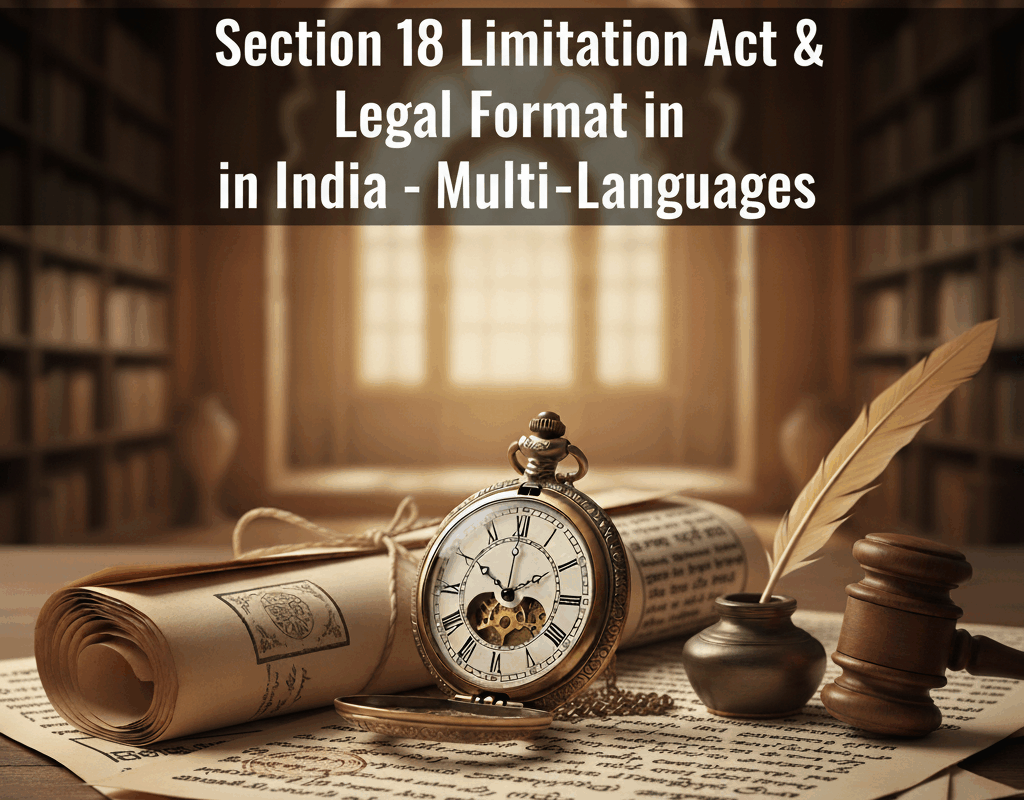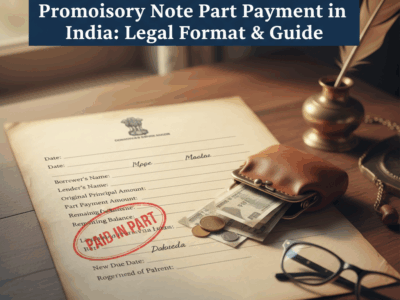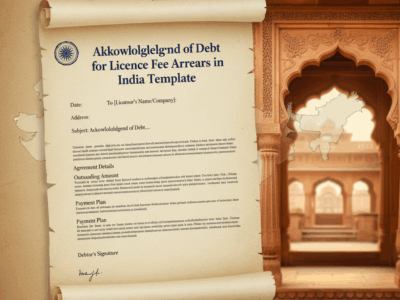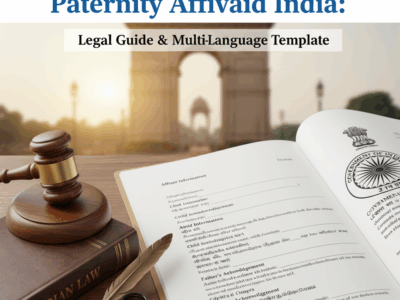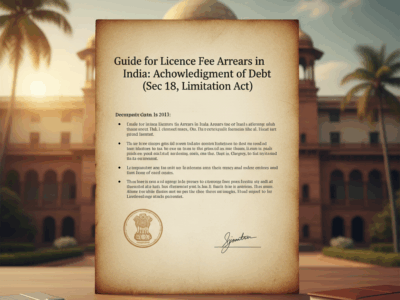Navigating the complexities of debt recovery in India requires a firm grasp of The Limitation Act, 1963, a law that dictates the timeline for legal action. A critical tool within this framework is the Acknowledgment of Debt, a simple yet powerful legal instrument that can reset the clock on a creditor’s right to sue. Governed primarily by Section 18, this document serves as an unequivocal admission of liability, providing a legal lifeline for recovering dues that might otherwise become time-barred. This comprehensive guide, updated for 2025, delves into the essential components of a valid acknowledgment, analyzes landmark Supreme Court judgments, and provides practical templates in English, Hindi, Bengali, Tamil, and Telugu to help both creditors and debtors strategically manage their financial rights and obligations.
Indian Contract & Limitation Law Explained
A Deep Dive into the Acknowledgment of Debt
Discover how a simple document can reset the legal clock on debt recovery, protecting creditors and defining liabilities for debtors. A definitive guide, updated as of October 2025.
The Race Against Time
The Limitation Act, 1963, sets a 3-year deadline for most debt recovery suits. See how an Acknowledgment acts as a legal 'time-turner'.
Scenario 1: No Acknowledgment
The 3-year clock runs out. The creditor loses the right to sue for recovery.
Scenario 2: Acknowledgment is Made
Acknowledgment Signed!
The creditor's right to sue is reset for another 3 years from this date.
Anatomy of a Legal Lifeline
This isn't just a receipt. It's a meticulously crafted legal instrument. Hover over each clause to understand its profound impact.
ACKNOWLEDGMENT OF PART PAYMENT OF A DEBT
I, (Debtor Name), S/o Sh. (Father's Name) hereby acknowledge that I have paid Rs. (Amount) in part payment of the total debt of Rs. (Total Amount) borrowed by me from Sh. (Creditor Name).
This payment is towards the debt on a pronote executed by me in his favour on (Date).
ऋण के आंशिक भुगतान की पावती
मैं, (देनदार का नाम), पुत्र श्री (पिता का नाम) एतद्द्वारा स्वीकार करता हूँ कि मैंने रु. (राशि) श्री (लेनदार का नाम) से उधार लिए गए कुल ऋण रु. (कुल राशि) में से आंशिक भुगतान के रूप में भुगतान कर दिया है।
यह भुगतान मेरे द्वारा उनके पक्ष में (दिनांक) को निष्पादित एक प्रोनोट (वचन पत्र) पर देय ऋण के प्रति है।
ঋণের আংশিক পরিশোধের স্বীকৃতি
আমি, (ঋণগ্রহীতার নাম), পিতা শ্রী (পিতার নাম) এতদ্বারা স্বীকার করছি যে আমি শ্রী (পাওনাদারের নাম) এর কাছ থেকে ধার করা মোট ঋণ (মোট পরিমাণ) টাকার আংশিক পরিশোধ হিসাবে (পরিমাণ) টাকা পরিশোধ করেছি।
এই অর্থ প্রদানটি আমার দ্বারা তাঁর অনুকূলে (তারিখ) তারিখে সম্পাদিত একটি প্রোনোটের উপর ঋণের জন্য।
கடனின் பகுதி చెల్లింపుக்கான ஒப்புதல்
நான், (கடனாளியின் பெயர்), த/பெ திரு. (தந்தையின் பெயர்) , இதன்மூலம் நான் திரு. (கடன் வழங்குநரின் பெயர்) என்பவரிடமிருந்து வாங்கிய மொத்த கடன் தொகை ரூ. (மொத்த தொகை) இல் பகுதி చెల్లింపుగా ரூ. (தொகை) செலுத்தியுள்ளேன் என்பதை ஒப்புக்கொள்கிறேன்.
இந்த చెల్లిப்பு, நான் அவருக்காக (தேதி) அன்று செயல்படுத்திய ஒரு புரோநோட்டின் மீதான கடனுக்கானது.
రుణం పాక్షిక చెల్లింపు యొక్క రసీదు
నేను, (రుణగ్రహీత పేరు), తండ్రి శ్రీ (తండ్రి పేరు) , శ్రీ (రుణదాత పేరు) నుండి నేను తీసుకున్న మొత్తం రుణం రూ. (మొత్తం మొత్తం) లో పాక్షిక చెల్లింపుగా రూ. (మొత్తం) చెల్లించానని ఇందుమూలంగా అంగీకరిస్తున్నాను.
ఈ చెల్లింపు నేను వారి పక్షాన (తేదీ) నాడు అమలు చేసిన ప్రోనోట్ పై ఉన్న రుణం కోసం.
The Four Pillars of Validity
For an acknowledgment to be legally valid under Section 18 of the Limitation Act, it must satisfy four core conditions.
In Writing
An oral admission of debt has no legal value for extending limitation. It must be a written document, email, or even a text message.
Signed by Debtor
The document must be signed by the debtor or their authorized agent. A digital signature is also legally valid.
Before Expiry
The acknowledgment is only valid if it's made before the original 3-year limitation period expires. It cannot revive a dead claim.
Unequivocal Admission
The language must clearly and directly admit the existence of the liability. Any conditions or disputes negate its effect.
Visualizing The Limitation Act
Compare the legal outcomes under The Limitation Act, 1963. See the powerful effect of a valid acknowledgment (Sec 18) versus a part payment (Sec 19).
Two Laws, One Debt: A Crucial Distinction
An "Acknowledgment" under the Limitation Act and a "New Promise" under the Indian Contract Act are not the same. Knowing the difference is critical.
Acknowledgment (Limitation Act, 1963)
Revives the remedy for a legally enforceable, existing debt.
- Timing: Must be signed BEFORE the 3-year limitation period expires.
- Language: A simple, clear admission of liability is enough. No promise needed.
- Legal Effect: Resets the 3-year limitation clock from the date of the signature.
New Promise (Contract Act, 1872)
Creates a brand new contract to pay a time-barred debt.
- Timing: Can only be signed AFTER the original limitation period has expired.
- Language: Requires an "express promise to pay." A mere acknowledgment is insufficient.
- Legal Effect: Forms a new, legally binding contract. The old debt is the 'past consideration'.
Strategic Use Cases in Practice
This document is a versatile tool in credit and risk management. Filter by perspective to see its application.
Preserving Rights
Proactively obtain acknowledgments during long-term loans to ensure the right to sue never expires.
The Trade-Off
While it proves payment, signing an acknowledgment consciously extends your liability period. Understand this before you sign.
Strengthening Litigation
An acknowledgment is powerful evidence, often enabling faster legal procedures like summary suits.
Corporate Debt & IBC
Crucial for initiating insolvency (CIRP). Balance sheet entries can act as acknowledgments, keeping debt alive for IBC claims.
Guarantor Liability
An acknowledgment from the main borrower can also extend the limitation period against the guarantor.
Partnership Debts
Nuanced Area: An acknowledgment by one partner doesn't automatically bind others unless specific authority is proven (Sec 20(2), Limitation Act).
The Balance Sheet Saga: A Supreme Court Story
Follow the landmark judicial journey that determined whether a company's balance sheet can be a valid debt acknowledgment.
PRE-2020
Conflicting Views
Various High Courts held that balance sheet entries were valid acknowledgments. However, a lack of definitive Supreme Court ruling led to legal ambiguity.
AUGUST 2020
NCLAT's Controversial Ruling
In V. Padmakumar v. Stressed Assets Stabilisation Fund, the NCLAT held that balance sheet entries are statutory compulsions and NOT valid acknowledgments, causing major disruption.
APRIL 2021
Supreme Court Settles the Law
In Asset Reconstruction Company v. Bishal Jaiswal, a larger SC bench overturned the NCLAT view, definitively ruling that a balance sheet entry CAN be a valid acknowledgment.
THE CRUCIAL CAVEAT
Not a Blanket Rule
The SC clarified that the acknowledgment must be unequivocal. If notes to accounts or the auditor's report indicate the liability is 'disputed', it negates the acknowledgment. A holistic review is now essential.
Best Practices & Common Pitfalls
Maximize legal efficacy by following key guidelines and avoiding common mistakes.
Drafting
- Be crystal clear and specific about parties, amounts, and the original debt.
- Avoid ambiguous or promissory language to prevent unintended legal consequences.
- Explicitly link the acknowledgment to the original promissory note.
Execution
- Ensure the debtor or a duly authorized agent signs the document. This is mandatory.
- Use independent witnesses. While not mandatory, it heavily strengthens your case against forgery claims.
- Verify the underlying pronote is properly stamped as per the Indian Stamp Act, 1899.
Common Pitfalls
- Conditional Language: "I will pay if..." invalidates the acknowledgment.
- Made Under Duress: Any acknowledgment obtained by force or fraud is voidable.
- No Link to Debt: Failing to connect the payment/acknowledgment to a specific debt.
Frequently Asked Questions
Addressing the most common queries about debt acknowledgments in India.
Can an email or WhatsApp message be a valid acknowledgment?
Yes. The Supreme Court has held that acknowledgments can be contained in electronic records. An email, SMS, or WhatsApp message can be a valid acknowledgment provided it is signed (e.g., with a digital signature or even a typed name intended as a signature) and meets all other conditions of Section 18.
Does paying interest or part principal automatically extend limitation?
Yes, under Section 19 of the Limitation Act. The payment of interest or part of the principal amount before the expiry of the limitation period starts a fresh period of limitation from the date the payment was made. However, the acknowledgment of payment must be in the handwriting of, or in a writing signed by, the person making the payment.
What if the debtor acknowledges the debt but refuses to pay?
This is the primary purpose of the acknowledgment. It is not a promise to pay but an admission of liability. This admission is what resets the limitation period, allowing the creditor to file a recovery suit for another three years. The debtor's refusal to pay after acknowledgment is the very grounds for the lawsuit.
What if the acknowledgment doesn't specify the exact amount?
An acknowledgment doesn't need to specify the exact amount of the debt. It only needs to acknowledge the existence of the jural relationship of debtor and creditor. The actual amount can be proven by other evidence (like the original pronote). However, it is always best practice to mention the specific amount to avoid disputes.
Navigate Debt Laws with Confidence
The Acknowledgment of Debt is more than paper; it's a powerful strategic tool. Understanding its nuances empowers both creditors and debtors to protect their interests effectively.
Have a Specific Legal Question?
Our team of legal experts at Evaakil.com can provide tailored advice for your unique situation, ensuring your rights are protected.
Schedule a Consultation
